Introducing SOFTacademy: Tackling the Technical and Societal Challenges of Modernist Neighbourhoods in Tallinn, Estonia
Introducing SOFTacademy
SOFTacademy in Tallinn, Estonia, is one of the 14 New European Bauhaus (NEB) demonstrator projects supported by the European Urban Initiative in the framework of the 1st Call for Proposals for Innovative Actions. The project aims to develop, test, and scale up a model for the collaborative reinvention of modernist districts into cozy living environments while accelerating the renovation of deteriorating housing stock.
Modernist neighbourhoods with mass-produced units are housing large numbers of people, representing one of the most prevalent forms of housing and type of neighbourhood in European cities. At the same time, such neighbourhoods are facing multiple challenges, at both technological and social levels, such as: the accelerated degradation of the building stock, energy inefficiency, lack of identity, and weakened social ties between inhabitants. Additionally, unlike traditional urban patterns, both the plan layout and architectural form prevalent in such areas have proved unable to change over time in response to their users' natural and ever-evolving needs.
The SOFTacademy project aims to tackle some of these challenges by employing a holistic approach that looks beyond renovating the outside of the buildings. The pilot area, located in the Mustamäe district, consists of four identical five-story prefabricated buildings and the public space around them on Akadeemia Street (no. 4, 6, 14, and 22), near the campus of Tallinn University of Technology (TalTech).
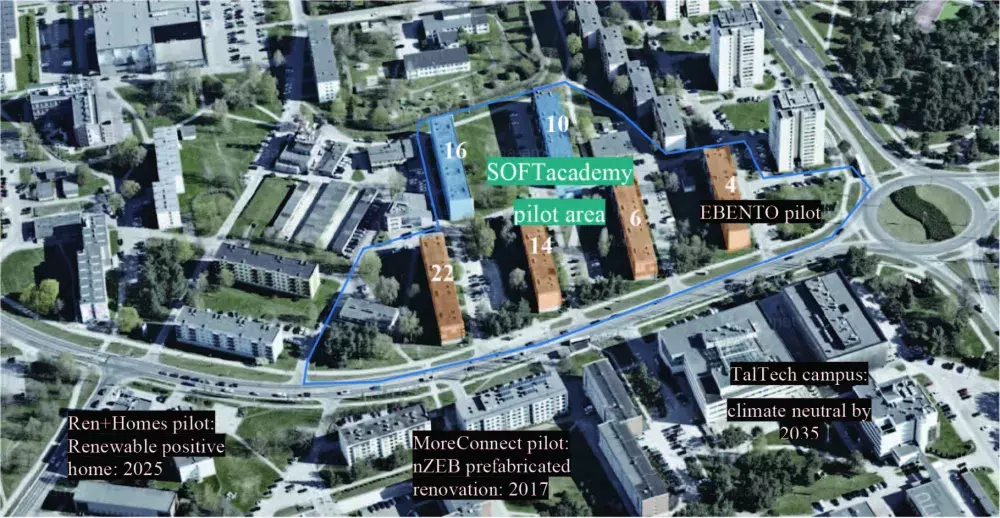
Project location map (in orange the buildings that are to be renovated, in blue reference buildings to be observed).
Credits: Murel Truu, Lauri Lihtmaa, Mariliis Niinemägi[1]
The solutions developed and tested by the project provide tools needed to enhance apartment building renovation on the neighbourhood level by engaging the inhabitants and other relevant stakeholders. One of the project's goals is to establish an example of how residents' initiative in renovation boosts neighbourhood-level redesign of the whole area, including spaces between buildings. The intervention logic, solutions, and digital tools developed can be transferred to similar mass-produced mono-functional districts that need change beyond just renovation. Furthermore, the approach aims to give a sense of place and identity by creating a better micro-climate, increasing biodiversity, accommodating community functions, and creating a cozier and more human-scale living environment.
A Diverse Array of Project Partners
The project engages various stakeholders, each bringing different knowledge, skills, and competencies to the table, complementing each other and thus contributing to the project's success. The holistic approach proposed by the project is reflected in the project's multidisciplinary team composition, which brings together strategists, architects, urban planners, landscape architects, engineers, public administration experts, social scientists, communication experts, and building administrators.
- Tallinn City (Main Urban Authority - MUA): lead partner; necessary improvements in city procedure and regulations; renovation accelerator service design, materials feeding the accelerator;
- Tallinn University of Technology (academia): renovation technology, data and information;
- MTÜ Living Street (local NGO): co-creation processes;
- Estonian Union of Cooperative Housing Associations (local NGO): engagement and capacity building;
- Yoko Oma OÜ (consultancy): reflection on the project impact and social change;
- LAB Verte (consultancy and design): design of public space, landscape solutions;
- Think Softer Planning AB (consultancy and design): Soft City concepts and transfer;
- Housing Associations Akadeemia tee 4, 6, 14, 22: engagement, administration.
One important component of the project is the transfer of knowledge, practices, and tools to other (European) cities facing similar challenges. The transfer partners of SOFTacademy are the City of Warsaw (Poland), the City of Lahti (Finland), and the Urban Municipality Krško (Slovenia).
The Innovative Building Blocks of SOFTacademy
The overarching innovative approach consists of changing the way in which renovation is undertaken in terms of scale, quality, and stakeholder engagement, aiming to accelerate the Renovation Wave based on New European Bauhaus principles.
SOFTacademy will provide both "hard" (materials, building components, technology, changes, and additions to the existing built form, where possible) and "soft" (participatory processes, citizens’ engagement tools) instruments necessary for accelerating and improving the uptake and quality of renovation. Through its different activities and developed tools, the project will contribute to increasing the knowledge and capacity of both communities and the local administration, aiming at creating mutual trust and long-term cooperation.
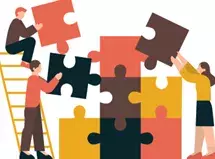
The innovative solution consists of the following innovative building blocks that are intertwined and reinforce each other.

Building block 1. Participation and Inclusion – Participatory Planning as a Tool for Renovation Projects
SOFTacademy seeks to change the way renovation processes take place by putting the communities at the heart of the process. Co-design will inform the decisions made, and inhabitants will be empowered to take a bigger role and provide input for the renovation project.
To ensure participation and foster inclusion, several activities and actions will be developed, tested, and finetuned during the project, such as organizing design workshops with the neighbourhood, focusing on inclusion of less represented groups: children, people with disabilities, elderly, minorities; organizing mini-publics; organizing hackathons open to the broader public, focusing on aspects of the projects that are hard to tackle; providing trainings to homeowners’ associations to increase their capacity and knowledge. These activities will be organized on-site (using analogue tools, physical models, and face-to-face conversations) or at the co-creation hub established at TalTech University, where technology (3D, virtual reality, etc.) will be used to increase knowledge and facilitate co-design processes.
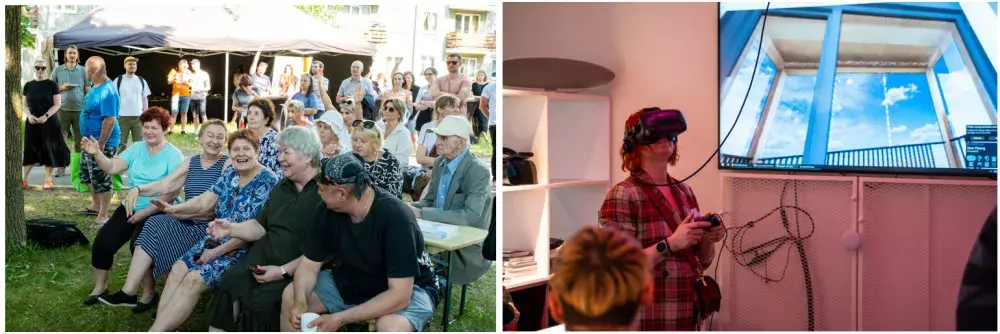
Credits: Aron Urb, Tallinn City
The intended result is the creation of a broad participation toolkit – the "Community Inclusion Model" that can be used in future renovation projects in Tallinn and elsewhere. The toolkit, consisting of activities, processes, and other instruments, will be institutionalized and formalized at the municipality level, serving as a participation and engagement tool for different projects (also beyond renovation), contributing to increasing the public acceptance and the quality of interventions at both building and open space level.
Building block 2. Renovation of Buildings – Applying a Circular and Carbon-Neutral Approach to Renovation
The project's renovation model will be executed using prefabricated (timber) modular elements. The modular system includes façade elements such as wall cladding with insulation, heating, water drainage and ventilation systems, windows, roof elements, balconies, and loggias. Interventions can go beyond that to incorporate elevator shafts, biodiversity-considerate solutions or solar panels. The complexity of the renovation package will be decided together with the inhabitants, according to their needs, the available budget, and the buildings' particularities.
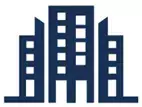
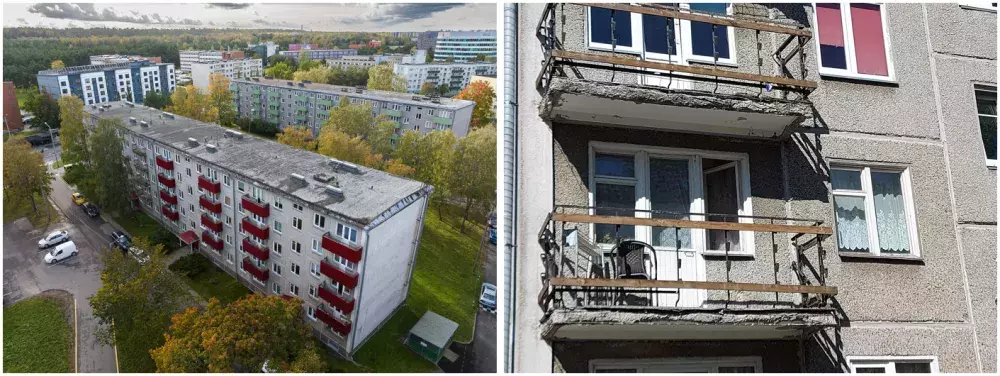
Credits: Sven Zacek (left), Ruxandra Aelenei (right)
The modular elements can be mass-produced, allowing the renovation pace to be scaled up. Furthermore, the modular components are developed and built based on circularity concepts: reducing waste during fabrication, installation, use, and disassembly processes using bio-based materials. The technology allows for quick installation with limited nuisance and impact on building occupants, who can continue to inhabit the building during works.
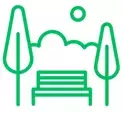
Building Block 3. Public Space - Reinventing the Outdoor Spaces between the Buildings by Applying the Soft City Approach
Renovation and energy efficiency improvement rarely include the public space between the buildings being renovated. SOFTacademy proposes improving the public or shared outdoor spaces, as well as the actual interface between the buildings and outdoor spaces, using the Soft City approach. The goal is to create more attractive spaces that encourage people to spend more time together outside, with the outdoor space functioning as an extension of their living areas.
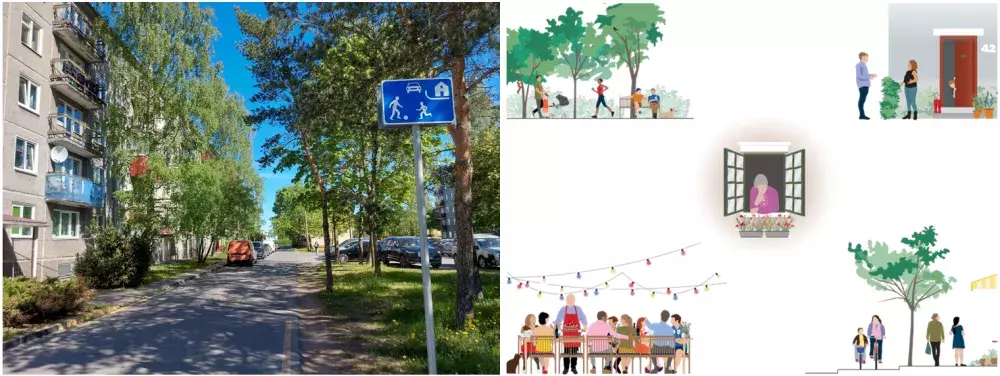
Source: Ruxandra Aelenei (left), David Sim[2] (right)
This concept aims to create urban spaces where humans can thrive as neighbours. Currently, the open spaces between the buildings feel anonymous, and no one knows what is allowed. The Soft City approach will introduce more significant differentiation between public places like streets and parks and common or shared spaces like courtyards. The outdoor space system will encourage interaction and everyday activities and can include smaller architectural elements added to the areas between buildings. The reorganization of the outdoor space will divide the current large open spaces into smaller, more private, and intimate courtyards, protected from the noise and fumes of the street.
These interventions aim to give the former 'no man's land,' often found in modernist districts, a new purpose, and better quality. They will create a sense of identity and belonging for the neighbourhood's inhabitants. This will increase the overall quality of life, preventing such districts from depopulating and becoming unattractive, monofunctional areas.
Building block 4. Administrative Processes - Streamlining the Renovation Process at City Administration Level
Local administrations often take a bystander approach during renovation projects, leaving the "national renovation marathon" to private owners and the state. This creates a patchwork appearance in districts and locks in the neighbourhood-level improvements. Through SOFTacademy, the city administration takes a significant and active role in accelerating the city renovation, becoming an active link between the existing national renovation (financing) programmes and the communities.
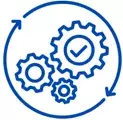
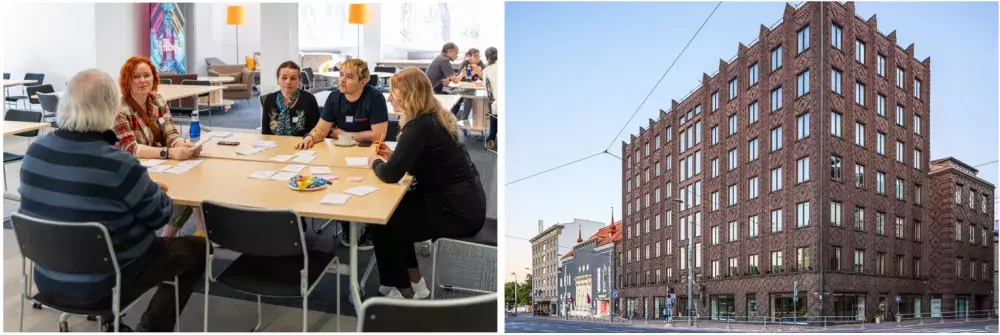
Source: Tallinn City
Tallinn City aims to establish a one-stop shop at the municipal level to streamline the renovation processes. At this moment, obtaining permits and all documents necessary for renovation interventions requires a lot of red tape; multiple departments and entities within the municipalities need to be consulted and issue approvals. These administrative hurdles slow down the renovation process and put off communities and citizens who want to take up renovation. The role of this new municipal service, „The Renovation Accelerator,” is to facilitate and accelerate private renovations by providing interested citizens with information, knowledge, support, and capacity building.
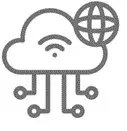
Building block 5. Digital and Data Systems - Creating Digital Tools that Streamline and Facilitate Renovation Projects
As part of the project, an open-access digital catalogue of renovation solutions will be developed, which other interested parties can use to replicate the project, ensuring the efficiency of future renovation processes. The catalogue will be a living document, being regularly updated, and will include the solutions of the upcoming innovation projects and possibilities for upscaling, being also used as a learning and knowledge development tool. The digital catalogue will consist of both the "hard" elements, as well as the "soft" measures applied in the project.
Furthermore, the consortium will develop a digital renovation strategy tool (ReSTo) that will be integrated with existing district-level databases using existing data from the national buildings registry, including high-quality digital twin of buildings, coupling building logbook data (LOD3) and digital energy labels of buildings with standardized renovation solutions. ReSTo will support decision-making when choosing a building stock's renovation strategy at the neighbourhood or municipal level. The tool will serve professionals and non-experts alike.
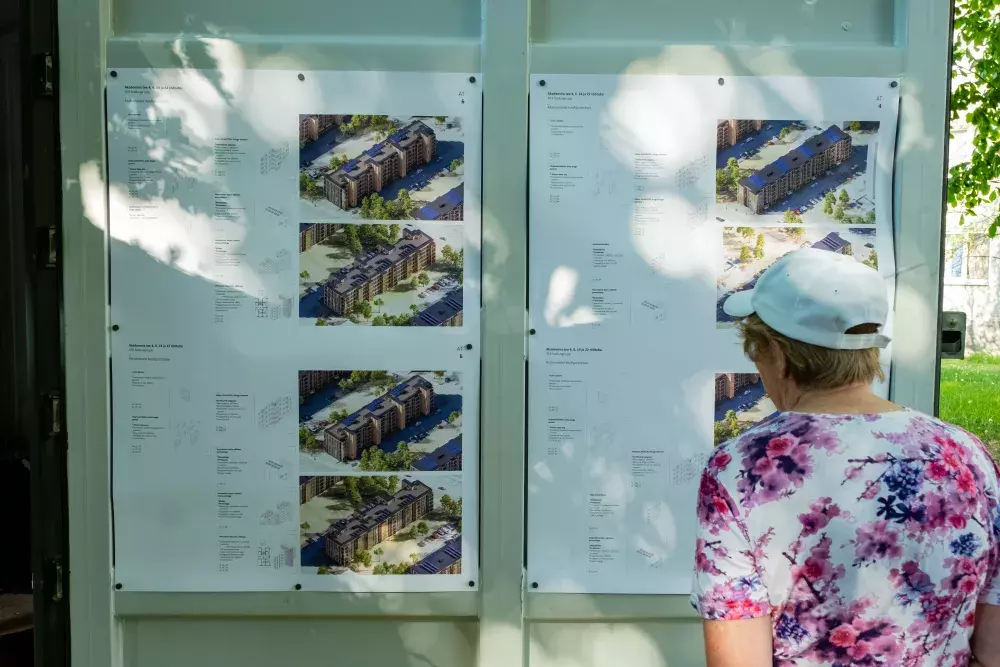
Source: Aron Urb
A First Glimpse into the Project’s Life
The project team was busy in the first six months of the project with fine-tuning the project goals and targets, establishing and deepening contacts with the neighbourhood’s inhabitants, setting up the knowledge hub at the TalTech site, and catalysing all needed forces and knowledge for the following three years.
One notable success that has already been achieved, due to the team's outstanding efforts, was reaching an agreement and consensus with the apartments' owners regarding the components of the renovation package that will be applied to the buildings. This has resulted from an intensive consultation process, with sometimes heated discussions, given that the content of the renovation package significantly influences the costs that inhabitants of the buildings need to cover. By providing the correct information and openly discussing the benefits and costs of the available options, an agreement has been reached, opting for an ambitious renovation package.
The team members also faced the first challenges and dilemmas inherent to any innovative project. Many questions have already been raised and will be explored in the coming period, to name a few:
"How can innovation be pushed through all bureaucratic and administrative rules, regulations, and procedures?"
"How do you involve all apartment owners, including less represented and less heard groups, such as children, elderly, and immigrants? And how can you give them a relevant role in the project?"
"How do you find additional needed financial sources to ensure the implementation of innovative, bold, and ambitious solutions?"
The project and its outputs will address these topics and many more, providing relevant knowledge and inspiration to other European cities facing with similar challenges. The project and its outputs will address these topics and many more, providing relevant knowledge and inspiration to other European cities facing similar challenges.
Note: This article has been written with the valuable contribution of the project’s team.
Follow us on our journey!
[1] Truu, Murel , Lauri Lihtmaa, and Mariliis Niinemägi. "Revitalizing Modernist Districts: Neighbourhood Level Mass-Renovation with SOFTacademy Project." Journal of Sustainable Architecture and Civil Engineering, no. 34 (1) (2024): 8-21. Accessed September 22, 2024. https://doi.org/10.5755/j01.sace.34.1.35646.
[2] Sim, David. 2019. Soft City: Building Density for Everyday Life. Island Press.
About this resource
The European Urban Initiative is an essential tool of the urban dimension of Cohesion Policy for the 2021-2027 programming period. The initiative established by the European Union supports cities of all sizes, to build their capacity and knowledge, to support innovation and develop transferable and scalable innovative solutions to urban challenges of EU relevance.
Similar content



